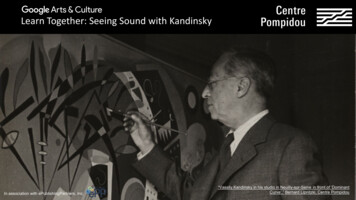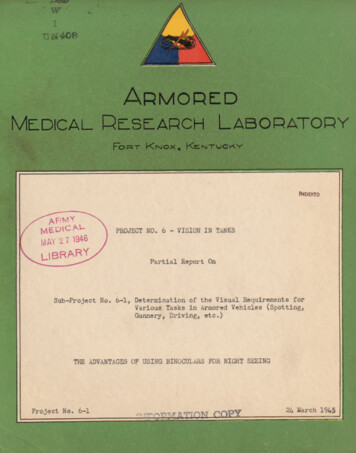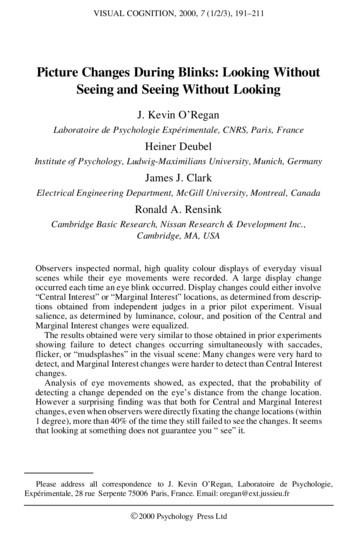
Transcription
Learn Together: Seeing Sound with KandinskyIn association with ePublishingPartners, Inc.“Vassily Kandinsky in his studio in Neuilly-sur-Seine in front of ‘DominantCurve’,” Bernard Lipnitzki. Centre Pompidou
Using the lesson plan and Google Arts & Culture resourcesThis lesson plan is designed to support you as you explore Google Arts & Culture stories and exhibits related to the lesson topic. Theimages you will see here are just a sample of the media—texts, images, audio, and video—available to you on the Google Arts & Culturewebsite and app. As the lesson uses only resources found on GA&C, it cannot present every aspect of a given topic. A parent or teachermight be guiding you through the lesson, or you might choose to complete it on your own.All you need to access the lesson is an internet connection and a web browser or the Google Arts & Culture app. You may want to takenotes, whether you do that digitally or with paper and pen.The lesson plan has an introduction, which will describe the topic and provide some background information that will help youunderstand what you are seeing, hearing, and reading. Then the lesson will take you on a journey from one Story to another, fill in somedetails along the way, and pose questions that will help you focus on important ideas. A quiz and a link for exploring the topic furtherare followed by ideas for projects related to the lesson topic that you can do at home or in the classroom.As noted, the lesson plan includes questions about the main stories, and there is also a quiz. You will want to write answers to thequestions in a notebook or on a piece of paper. Then you can check all your answers when you’ve finished the lesson.Resources on the Google Arts & Culture website include Themes, Stories, Museum Views, items, and images. Themes bring together stories, exhibits, collections, images, audio, and video files that relate to a topic. In a Story, clicking on the arrows on the right and left sides of a slide will move you forward and backward. Just keep clicking to keepmoving forward. (Note that in some stories, you scroll up and down.) Audio and videos on slides will play automatically. Clicking on animage title will take you to a page with more information about it. In Museum Views, you move through a 3D space. Click to move forward. Click, hold, and move the cursor left or right to turn. An item will take you to an individual image, where you can zoom in and sometimes read more about the artefact.2
In this lesson, you will learn about: The features of abstract art. The well-traveled life of painter VassilyKandinsky. How Kandinsky’s life and travels helpeddevelop his technique and style. What synesthesia is and how it influencedKandinsky.You will: Explore some stories and exhibits aboutKandinsky and his life and art. Answer some questions about what youhave seen and read.This lesson will take 30–45 minutes tocomplete.”Vassily Kandinsky in his studio in Neuilly-sur-Seine in front of ‘DominantCurve’,” Bernard Lipnitzki, 1938, Centre Pompidou3
Learn Together: Seeing Sound with KandinskyIn the early 20th century, artists began to turn away from traditional paintings. Instead ofcopying the world by making realistic pictures of people, events, or landscapes, artistsbegan expressing how they felt. They used bright or unrealistic colors to show a certainmood. They painted simple shapes to show the building blocks of an image. Finally,they stopped painting “things” entirely. The result was abstract art. This new type ofpainting forever changed how artists could communicate with their audience.The painter Vassily Kandinsky was born in Russia but traveled across Europe andNorthern Africa during the chaotic and war-torn years of the early 20th century. Hehelped lead a movement of artists who expanded what art could be. His own artgradually became a pure expression of colors, lines and shapes, and his classes atschools such as the Bauhaus in Germany influenced hundreds of others. He also usedhis unusual brain condition, called synesthesia—which you will learn about in thislesson—to express feelings through art.Kandinsky’s art is still beloved for its combination of playful colors, shapes, and lines,and his careful, almost mathematical teachings about how to make abstract images.As you view the exhibits and stories in this lesson, think about these questions: How does abstract art express what the artist feels? How did Kandinsky’s life and travels influence and change his art? How did Kandinsky use his synesthesia to develop abstract art?”Watercolor N 325”, Vassily Kandinsky, 1928. Centre Pompidou4
Vassily Kandinsky, A Pioneer of Abstract ArtAbstract art does not portray a specific scene or object. (Art that showsobjects, like portraits and landscape paintings, is called figurative art.)Instead, it uses color, shape, and line to directly express ideas or feelings.Though abstract art is considered “modern,” abstract designs are as oldas prehistoric decorated pottery or symbols carved into ancient ruins.Kandinsky began his career painting figurative scenes. But as heexplored traditional Russian folk art, Islamic decorative arts, andEuropean art movements such as Impressionism, he gradually developeda style using pure shapes, lines, and colors that helped pioneer abstractart.Click here to learn about early abstract art.Then come back to answer these questions:1. What painting first inspired Kandinsky to consider abstract art?2. How did Kandinsky and the Fauves first move away from paintingrealistic images?3. How does figurative art express ideas, and how does abstract artexpress ideas?To learn about the theories of abstract art Kandinsky taught at theBauhaus, click here.”Composition,” Vassily Kandinsky, 1944. Centre Pompidou5
Russian Folklore: An Everlasting Source of InfluenceAs a young man, Kandinsky traveled to traditional Russian villages.Though he wasn’t an artist yet, he was immediately struck by howthe villagers surrounded themselves with colors and shapes paintedor carved onto their homes, churches, and everyday objects.Kandinsky found especially captivating the use of color on a darkbackground, which creates a “stained glass” effect. Years later, herevisited this technique to depict characters from folklore and toexperiment with the relationships between color, shape, and line.Click here to learn about Kandinsky’s experienceswith Russian folklore.Then come back to answer these questions:1. What materials did Kandinsky use to re-create traditional Russianfolk images?2. What types of images did Kandinsky create using his techniques?3. What other folk techniques and folklore did Kandinsky incorporateinto his art of this period?To learn about Kandinsky’s use of color-on-black, click here.”Lied (Song)” (detail), Vassily Kandinsky, 1906. Centre Pompidou6
How Travelling Inspired Kandinsky’s PaintingKandinsky traveled throughout his life. As a child and youngman, he journeyed throughout Russia. After deciding tobecome an artist, he traveled to Germany and to variousEuropean capitals. As an artist, he went on many long tripsthrough Europe and North Africa. World events such as theRussian Revolution and the two World Wars also forced himto move.Kandinsky was inspired by both the landscapes and the localart everywhere he went. Each place he visited contributed tohis changing outlook on art and abstraction.Click here to learn about Kandinsky’s art andtravels.Then come back to answer these questions:1. Why did Kandinsky leave Russia?2. What kind of art did Kandinsky produce while he was onthe road, and why?3. How did Kandinsky’s travels contribute to his abstract art?To learn about the places Kandinsky lived, click here.”Arabische Stadt (Arab Town)” (detail), Vassily Kandinsky, 1905.Centre Pompidou7
Hearing Colors/Play a KandinskyKandinsky had a condition called synesthesia. People withsynesthesia experience more than one sense at once. Whenthey hear sounds, they might also see colors. Colors, shapes,letters, numbers, or even days of the week might make sounds.Kandinsky used his synesthesia to form theories about abstractart. For Kandinsky, each shape and color made a certain soundthat helped communicate his feelings and ideas.Click here to learn about Kandinsky’ssynesthesia.Click here to experiment with what Kandinskymay have heard in one of his paintings.Then come back to answer these questions:1. What senses did Kandinsky experience together?2. How are the elements in Kandinsky’s art similar to theelements that make up music?3. Do you think people with synesthesia get more out ofabstract art than people without it? Explain.To learn about how music inspired Kandinsky’s art, click here.”Gelb, Rot, Blau” (detail), Vassily Kandinsky, 1925. Centre Pompidou8
QuizRead the questions and write your answers in your notebook or on a piece of paper.1. What visual elements did Kandinsky use in his abstract art, and what did those elements express?2. Describe at least two ways that Kandinsky’s figurative art gradually changed to become moreabstract.3. What techniques are used in both traditional art, such as Russian folk art, and abstract art?4. What elements of folk art did Kandinsky use in his own paintings?5. How did Kandinsky’s travels move his art in a more abstract direction?6. How did war and other world events affect Kandinsky’s art career?7. How did music inspire Kandinsky’s career throughout his life?8. How did Kandinsky’s synesthesia influence his art and teaching?Explore FurtherThis lesson has given you some vocabulary to talk about abstract art and Kandinsky’s work. To learnmore about Kandinsky and abstract art, click here.9
It’s Your Turn!In this lesson, you learned about how Kandinskytranslated his life, his experiences, his travels, and hissenses into art. Now it’s your turn to do something.Here are some ideas for projects that you can do athome or in the classroom. Listen to your favorite song. Choose severalcolors and shapes that remind you of the music.Create a piece of art to express the music andhow it makes you feel. Find a photograph or a figurative painting you like.Try to simplify the shapes or change the colors tomake it abstract. You can even reproduce theimage using a collage of simple colored shapescut out from construction paper. Make your own “key” or guide to how colors orshapes make you feel. Arrange blocks of colors ortypes of shapes in a notebook or on poster paper.Below each, list the feelings you associate witheach color or shape.”Auf Spitzen (On the points),” Vassily Kandinsky, 1928. Centre Pompidou10
AnswersHearing Colors/Play a KandinskyWassily Kandinsky, A Pioneer of Abstract Art1. Kandinsky associated colors and shapes with sounds and feelings, suchas yellow with trumpets and repeating lines with restlessness.2. Kandinsky tried to create interaction and harmony between colors, lines,and sounds that represented interacting moods, similar to how sound andrhythm create emotion in music.3. People with synesthesia might experience sensations when viewingabstract art that people without the condition do not. However, everyonecan relate to abstract art based on the emotions evoked by colors andshapes.1.2.3.Kandinsky was inspired by Claude Monet’s painting, Haystacks (LesMeules).Kandinsky and the Fauves both painted scenes but used unrealisticcolors that expressed feelings rather than lifelike accuracy.Figurative art expresses ideas through the subject of the painting. Forexample, a portrait of a person wearing jewelry might express theidea of wealth. Abstract art uses lines, shapes, and colors to expressfeelings directly.Russian Folklore: An Everlasting Source of Influence1. Kandinsky used tempera paint on dark cardboard.2. Kandinsky made paintings of stories from Russian and Europeanfolklore and also landscapes of Moscow.3. Kandinsky incorporated images and folklore from his travels in NorthAfrica. He also incorporated Viking (Norse) and German folklore tocreate a combination of images.How Traveling Inspired Kandinsky’s Painting1. The first time Kandinsky left Russia was to study painting in Germany.He left the second time because of political and artistic disagreementswith the Bolshevik regime.2. Kandinsky created quick studies of landscapes, often using oil paintsand a palette knife. These materials are easier to use while traveling.3. Kandinsky saw examples of abstract images such as architecturaldecoration in Russia and in North Africa. Buildings and light in differentplaces also influenced the shapes and colors in his art.11
AnswersQuiz1. Kandinsky used broad areas of pure color, dark lines and shapes, andrepeated elements in his abstract art to create a musical interaction ofmoods and playful feelings.2. Kandinsky changed his figurative art by using different, brighter colorsand by simplifying shapes.3. Russian folk art and other traditions such as Islamic art can beconsidered abstract because they use simple shapes to expressfeelings without showing realistic objects.4. Kandinsky used both subject matter and painting techniques fromRussian folklore in his art. He painted pictures of stories andcharacters from folklore, and he used the traditional color-on-blackstyle of some traditional Russian art.5. As Kandinsky traveled, he used elements of Russian folk art, thebright colors and flat shapes of Mediterranean art and architecture,and the bright colors of the Fauves and Impressionists he saw.6. World events often forced Kandinsky to move. In the case of theRussian Revolution, he found that his art thrived when he left Russiafor Germany. However, the Nazis shut down the Bauhaus, where hehad been a productive artist and teacher.7. Kandinsky was inspired to make pictures based on the colors he sawwhen he heard music, and he played music and worked withcomposers.8. Kandinsky’s synesthesia made specific links between colors, shapes,sounds, and feelings. He developed and taught theories that showedothers these links and how
Learn Together: Seeing Sound with Kandinsky. 2. This lesson plan is designed to support you as you explore Google Arts & Culture stories and exhibits related to the lesson t opic. The images you will see here are just a sample of the media—texts, images, audio, and video—available to you on the Google Arts & Culture website and app. As the lesson uses only resources found on GA&C, it .











